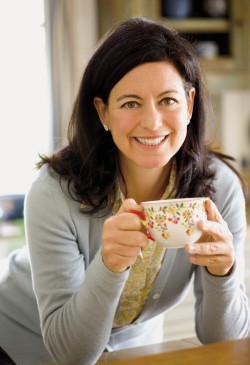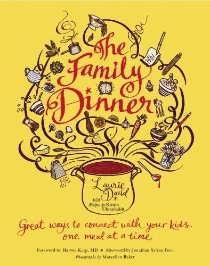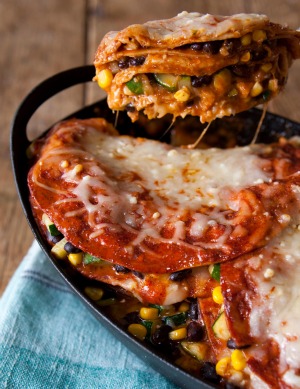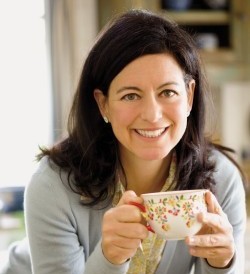 Laurie DavidPhoto: Maryellen BakerLaurie David — climate activist, producer of An Inconvenient Truth, founder of the Stop Global Warming Virtual March — is putting her focus closer to home these days. Right in the home, actually — at the dinner table.
Laurie DavidPhoto: Maryellen BakerLaurie David — climate activist, producer of An Inconvenient Truth, founder of the Stop Global Warming Virtual March — is putting her focus closer to home these days. Right in the home, actually — at the dinner table.
Her new book, The Family Dinner: Great Ways to Connect With Your Kids, One Meal at a Time, offers a lively mix of recipes, dinner conversation topics, and tips for engaging kids at the table. Sprinkled throughout are ideas and reminiscences about family dinners from big names like Robert F. Kennedy Jr., Nora Ephron, and Maya Angelou, plus food celebs like Mario Batali, Jamie Oliver, and Michael Pollan.
She stopped by the Grist office last week to chat about the book.
Q. A lot of people are paying more attention to where their food comes from, but has the social aspect of how we eat our food been missed?
A. As the family dinner has declined over the past 30 years, all these disturbing health problems have increased — obesity and diabetes. We’re feeling the social ramifications of not doing this ritual the way our parents and grandparents did.
The other piece of this that’s creating challenges for parents is the computer and the cell phone and the text messaging. Everything about our current lifestyle is pushing away connectedness. That’s why it’s so important to put your foot down and recapture this ritual. It’s the key way that people are civilized. It’s how you learn manners. It’s how you get to taste new foods and develop a palate. It’s how you learn to listen and have a conversation. It improves your vocabulary. It’s where you develop your debating skills. Hopefully at the table you’re discussing world affairs and learning to have a social conscience.
Q. You talked to a lot of interesting people about their own family dinners. Did you take any ideas from those back to your own house?
 A. Yes. I was very inspired by the interview with Bobby Kennedy — in his family growing up, you not only had to participate, you had to do a book review, or you had to write a biography [of a prominent figure], or you had to memorize a poem.
A. Yes. I was very inspired by the interview with Bobby Kennedy — in his family growing up, you not only had to participate, you had to do a book review, or you had to write a biography [of a prominent figure], or you had to memorize a poem.
I love this old-fashioned idea of poetry at the dinner table. Kids used to learn poetry in school in first or second grade, and you came to the table and you recited it. Everybody applauded, and the self-esteem that the kids got from it was incredible. I didn’t teach my kids poetry, but my boyfriend has a 7-year-old and we’re teaching her poetry.
Are you a parent?
Q. I’m not.
A. I think this book is fantastic for single people, too. Your family is whoever you sit down to eat with. So if you’re single, your family is going to be your girlfriends or your coworkers. One man sent me an email saying that all his kids had left home, but this was inspiring him to have dinners with his wife.
I’m hoping the book will give everybody incredible recipes, but also all these ideas on how to talk at the table, how to make it so that it’s not a stressful time. It’s not about the dinners being perfect, it’s about them just being fun.
Q. Yes, my partner and I don’t have kids, but I still find that it’s really worthwhile to make the effort to sit down and have dinner together, put aside our laptops and The New York Times. You’re inspiring me to make that a ritual.
I also appreciated your admission that it’s not always easy to have a good conversation at the dinner table.
A. You have to create it. I can’t tell you how many people I interviewed who said, “We had regular family dinner, but nobody talked.” For some people, the conversation is as challenging as preparing the food. This book is going to help those people.
I come from the philosophy that if you’re at the table, you have a responsibility to participate. I think we have to teach our kids that, too. You don’t get to just come and eat and then leave. You have to be excited about what you’re eating. You have to tell the person who prepared the food how good it is. You have to contribute in some way.
Q. Is climate change a good dinner-table topic?
A. Always, of course. We talk about it a lot in my house. Here’s a simple way to take this from a huge issue right down to your dinner plate: One of the easiest, quickest things you could do to reduce your carbon footprint is to eat a little less meat.
Q. You have a section in the book about Meatless Mondays. Would you call yourself a less-meat-etarian, as food writer Mark Bittman puts it?
A. I call myself this because I heard Paul McCartney use it: I’m a “meat reducer.” I hate labels, I think labels hold us back. There are a lot of great recipes in the book that have vegetables as the main ingredient. I don’t even like calling them vegetarian dishes because that sounds like something’s missing — there’s a stigma to it. It’s just delicious, great food that features vegetables.
So this is a great ritual. Start Meatless Mondays in your family, and talk about why — why we should be eating a little less meat, how it’s healthier for us, how it’s better for the planet. My family is now meatless on Mondays, Tuesdays, and Wednesdays. Also, if you eat meat less, you’re going to enjoy it more.
Q. You’re a dedicated climate activist, and this election was disheartening for many of us. Any insights on where we should focus going forward?
A. Almost every single environmentalist I know is an optimist, so I’m trying to remain optimistic as well. I feel like the change has to come from the individual, and that will push up against government. But I think we’re not doing enough. Maybe it’s time for a new movie.
Q. Do you have one in the works?
A. I don’t. But I’m going to start thinking about it.
For now, I’m going to enjoy the Family Dinner book, and cook from it, and enjoy the conversation that is going to come from it. I hope to make a Family Dinner 2 and fill it with tons more ideas to inspire everybody to take this gift that each day gives us and enjoy it.
Q. Can you pick one favorite recipe from the book?
A. It’s almost impossible, but I could say I love any of the recipes that have kale in them. There’s a recipe called “Oven Grains, Greens, and Cheese, Please.” I urge everybody to try this — it’s a whole meal in one pan. Don’t say your kids won’t eat it. They’ll eat it if it’s delicious and if you’re enjoying it.
And if you make the Danish meatballs [“Kirstin’s Nanna’s Frikadeller”], make a ton of them because you’re not going to be able to stop eating them. And the Asian shrimp cakes. They’re easy!
Editor’s note: Read on for a recipe from the book
 Enchilada pie.Photo: Maryellen Baker
Enchilada pie.Photo: Maryellen Baker
Vegetable Enchilada Pie: No Fuss, Less Mess, but So Good Nonetheless
Great enchilada sauce + cheese = great enchiladas. It is that simple. So here is the recipe for a great but easy-to-make enchilada sauce. The enchiladas are quick since you stack the tortillas instead of roll them. And why don’t we toss in some vegetables as healthy extras? As usual, the vegetables listed here are only suggestions; use whatever you have in your fridge or garden.
Makes 6 servings
For the enchilada sauce (makes 3 1/2 cups):
2 tablespoons olive oil
2 cups chopped onions
4 cloves garlic, minced
5 tablespoons chili powder, mild or hot
2 tablespoons cumin
1 shredded corn tortilla
1 28-ounce can diced tomatoes, drained (fire-roasted tomatoes are great for this) for this)
2 tablespoons brown sugar or maple syrup
1 (spicy) or 2 (really spicy) chopped chipotle chiles from a can (optional)
1 cup water or stock
Salt and pepper to taste
Heat a large pot over medium heat and drizzle in enough oil to cover the bottom. Sauté the onions until golden, then add the garlic, chili, cumin, and tortilla, stirring for a moment until fragrant.
Add the remaining ingredients and simmer for 20 minutes. (Now is a good time to start cooking the vegetables for the filling.) Put the sauce in a blender — you might need to do it in batches — and blend until smooth. Taste and adjust the seasonings. This can be made ahead and refrigerated or frozen.
For the filling:
2 tablespoons olive oil
1 medium onion, chopped
2 medium cloves garlic, chopped
2 cups shucked fresh corn or defrosted frozen corn
1 cup chopped zucchini
1 cup chopped asparagus
1 teaspoon dried oregano (optional)
3 cups canned black beans, drained very well
2 4-ounce cans mild chopped green chiles, drained very well (optional)
1 cup of your favorite salsa (if it is very watery, drain some of the liquid)
1 cup low-fat sour cream or plain Greek yogurt
About 14 corn tortillas, 5-6 inches each
3 cups shredded Mexican cheese or mozzarella
Heat a large nonstick skillet over medium heat and drizzle in enough oil to cover the bottom. Sauté the onion until golden, then add the garlic, stirring for a minute until fragrant.
Add the corn, zucchini, asparagus, and oregano. Sauté the vegetables until they are heated through but still crisp, about three to four minutes. Add the beans to the pan and put it aside.
In a bowl, mix the green chiles, salsa, and sour cream.
Preheat the oven to 400 degrees.
Cover the bottom of a medium-size baking dish with a thin layer of enchilada sauce, put a layer of tortillas on top, cover them with enchilada sauce, then vegetables, the sour cream mixture, cheese, another layer of tortillas … and keep going until you reach the top, ending with a layer of sauce.
Cover tightly with foil and bake in the oven for 30 minutes. Take off the foil, sprinkle with some cheese, and bake for 5 additional minutes.
Serve with guacamole, a salad — and enjoy.




